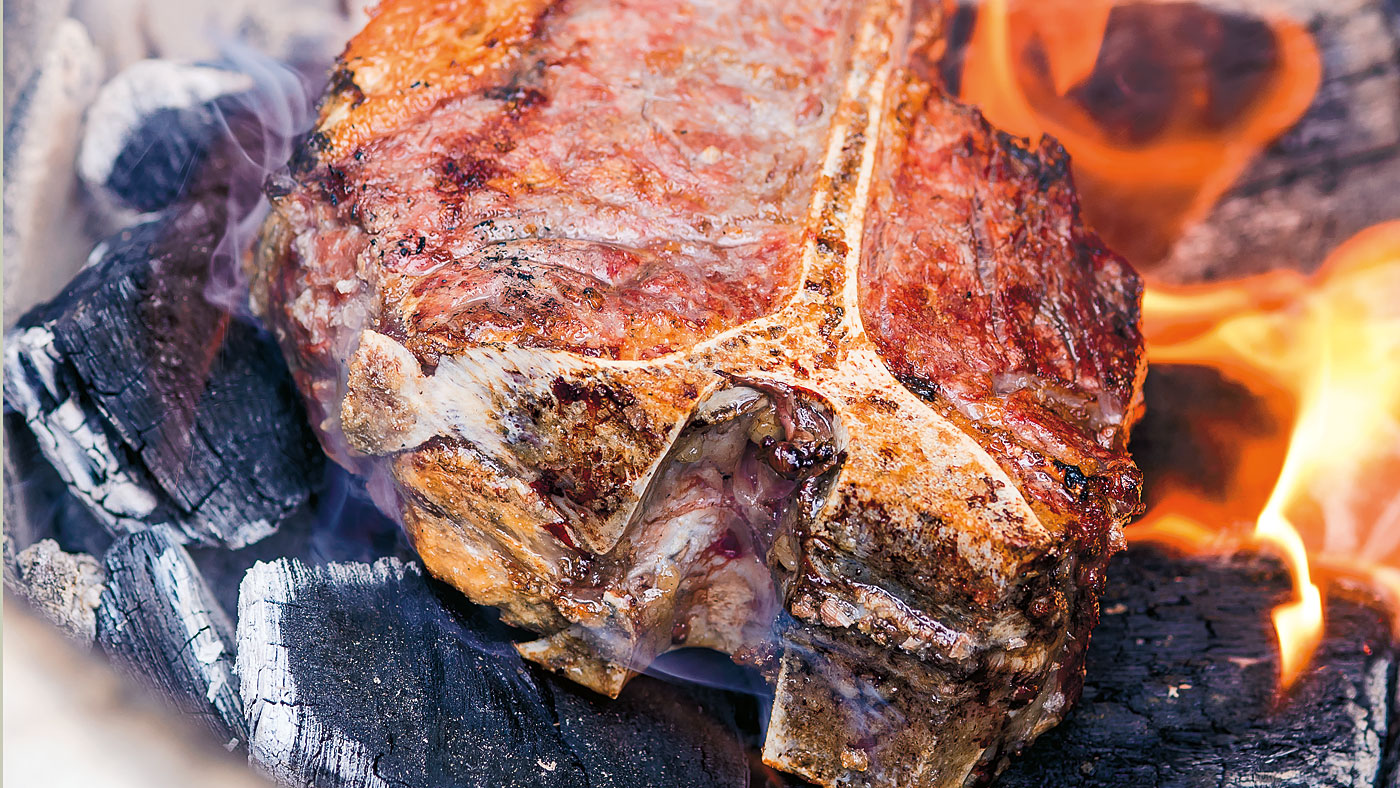How to cook the perfect steak
In an extract from his new book, Hawksmoor executive chef Richard H Turner explains how to prepare your favourite cut of meat

There is no such thing as a perfect steak, of course – nature doesn't work that way, and the flavour of steak is subjective. However, these are my preferred cooking methods.
My perfect steak has a sweet, meaty smell and taste, has a flavour that keeps on going in the mouth, and is moreish and beefy. It has been hung for around five weeks (excessively hung meat can mask inferior meat). When raw, it is not wet or sticky, nor is it soft or mushy.
It is a brighter red colour than the well-marbled, intensively grain-fed steak, which is often graded by the amount of white and creamy marbling. In my perfect steak, if the marbling is visible at all, it is a pale yellow intramuscular fat that has been laid down slowly – more often, however, it is invisible to the naked eye.
The Week
Escape your echo chamber. Get the facts behind the news, plus analysis from multiple perspectives.

Sign up for The Week's Free Newsletters
From our morning news briefing to a weekly Good News Newsletter, get the best of The Week delivered directly to your inbox.
From our morning news briefing to a weekly Good News Newsletter, get the best of The Week delivered directly to your inbox.
The science behind cooking a perfect steak
Maillard is the chemical reaction that occurs when meat is browned, and it is one of the main reasons that grilled and roasted meat tastes so delicious. Maillard begins at 140-170°C (284-338°F). Knowing the correct temperature that a grill or pan needs to reach for Maillard to happen, recognizing the right time to season the meat and put it on the grill, and understanding how sugars and amino acids in meat combine at high heat to produce reactions and flavour compounds, can only help us become better cooks.
Different cuts of meat have varying degrees of tenderness, which can largely be attributed to the collagen in each muscle. Collagen is made of naturally occurring proteins and is the main component of connective tissue in muscle. The strength of the collagen varies in different cuts of meat and is also dependent on the age, breed and sex of the animal.
Muscles that do very little work have weak collagen. Prime cuts generally have less connective tissue and collagen and are consequently more tender. Less expensive cuts usually have more connective tissue and collagen and so tend to be tougher.
A free daily email with the biggest news stories of the day – and the best features from TheWeek.com
Understanding collagen is an important part of understanding cooking. In order to turn a tougher, collagen-rich cut into something delicious, juicy and tender, the muscle must be cooked with a lower, even heat so that the collagen molecules unravel, break down and dissolve into soft gelatine that bastes and moistens the meat.
Preparation
Allow the steaks to sit for 30 minutes in order to come up to room temperature; this is known as tempering. Then dry the steaks off, because wet steak will struggle to form a decent crust and can pick up some unpleasant boiled-meat flavours – although once the steaks have been tempered at room temperature, they are already slightly drier than they would be straight from the refrigerator.
Seasoning
I like pure Maldon sea salt flakes to season steaks; I never use table salt. This is because table salt is saltier and contains anti-caking agents which are not suited to steak. I season aggressively, throwing handfuls of salt at the steak, shaking it over the tray before cooking it. During this process, much of the salt falls off, and what's left is the correct amount of seasoning, in theory.
As with everything, there are variables to watch out for: thicker steaks, such as chateaubriands and bone-in ribs, require more seasoning than thinner steaks because of their lower ratio of surface area to meat. Not all steak is hung for the same amount of time, and it's important to note that steaks of different ages take seasoning differently. If you think about it, it's obvious that a younger, wetter steak will absorb more seasoning than an older, drier one.
The amount of salt required also varies according to cooking method. On a grill with bars, much of the salt falls off the steak and onto the charcoal; when cooking in butter, some of the salt dissipates into the butter; and when cooking in a pan with minimal fat, almost all of the salt remains on the steak. A truly great steak cook understands all these variables and adjusts the seasoning marginally according to the thickness, age, moisture content and cooking method of each steak. Some say you shouldn't season the steak until after you've cooked it – they're wrong.
When is it cooked?
Some say to prod different parts of your hand or face and compare with the texture of the steak to tell when it is cooked, but this is not a reliable method. There is no particular test that will tell you when a steak is perfectly cooked to your liking, and only with practice and experience you will get used to the "feel" of the correct cooking temperature.
It is also worth bearing in mind that cooking temperatures are subjective and perceptions vary from country to country. My cooking temperatures are perhaps a touch more cooked than those of, for instance, a Frenchman or Spaniard, and this is deliberate. Most of the great steak cuts contain fat and fat needs to be at a certain temperature to be digestible, and do its job of lubrication and flavour transfer. It's for this reason I don't cook steaks rare, except under duress.
These are the temperatures I work to, bearing in mind the internal temperature should be at the bottom end of each range at the end of cooking and towards the top end once rested. Medium-rare: 55–60°C (130–140°F) Medium: 60–65°C (140–150°F) Medium-well done: 65–70°C (150–160°F)

How to cook the perfect steak
Cooking over charcoal
Cooking on a live fire grill is a skill and craft all of its own, made easier by the performance and quality of the material you're burning.
Success in cooking over a flame, whether direct or indirect, is down to the ability to control temperature, and while it is possible to give you guidance as to how to do this, the technique can really only be learned through practice. Just keep lighting your grill and cooking on it, and you will begin to understand the hot spots and cool spots, how long it takes for the coals to burn down for the optimum grilling temperature, and how long a full load of charcoal lasts.
Light the grill early enough to allow it to die down before cooking the first piece of meat. Make sure the grill is hot, but not too hot: the charcoal should have burned down and be coated in white ash. It should not be so hot that you can't stand close to it; if it's too hot for you, then it's probably too hot for the steak.
The aim is to get a good char on the outside while keeping the meat juicy and tender inside, which is impossible with a thin piece of meat – ideally, the steak should be at least 4cm (1.5 inches) thick.
Take it out of the refrigerator 30 minutes before cooking, to bring it up to room temperature. At the last second, season the meat well, but don't use any oil on it – if the grill is at the correct temperature, the meat won't stick.
Cooking in butter
Take the steak out of the refrigerator 30 minutes before you're planning to cook, to allow it to come to room temperature. Heat a heavy-based griddle pan or frying pan over a medium-high heat, then season the steak lightly, bearing in mind that less falls off in a pan than on a grill.
Put it flat-side-down in the pan and cook for 90 seconds on each side, pressing down with a spatula, until both sides are well browned. Add the butter, and some garlic and thyme if you are using them. The rapidly melting butter, flavoured with crushed garlic, is then used to baste the steak as it cooks. This gives it a gorgeous richness; the browning butter helps to impart some lovely, savoury flavour to the crust along with the garlic.
In theory, you remove the steak from the pan and leave it somewhere warm to rest for 10–15 minutes, then serve. However, if the steak is thick enough, I've been known to turn the heat off early and allow the steak to rest in its pool of butter in the pan instead. Frequent flipping is the key to moist steak, as neither side has the time to absorb – or to release – large amounts of heat. The meat cooks faster and its outer layers end up less overdone.
PRIME: The Beef Cookbook by Richard H. Turner is published by Mitchell Beazley, £25 (or £17 on Amazon)


